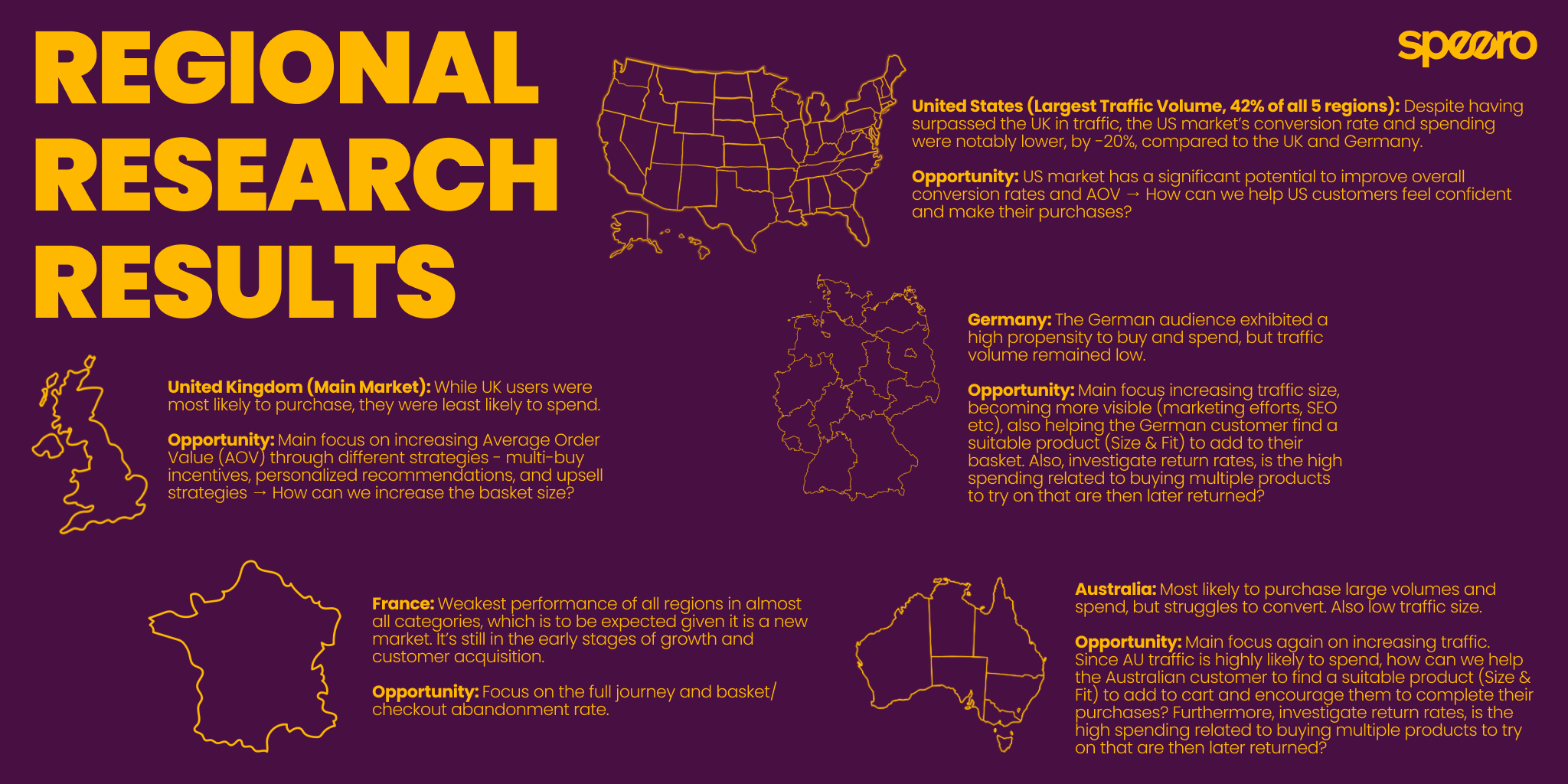TLDR:
- Problem. A successful experimentation program was experiencing diminishing returns.
- Solution: A two-phase regional research initiative that used existing analytics and session recording tools to analyze regional performance and user segments, identifying specific behavioral nuances without incurring extra costs.
- Results: A clear optimization roadmap, enabling tailored strategies for each region and segment, ultimately ensuring continued growth and impactful results by addressing diverse customer needs.
Even successful experimentation programs that have been going on forever hit a wall. How do you keep momentum, find insights, innovate, and generate new ideas to research or test after so much time and so many won tests? Regional research may be your answer.
The Speero team, after years of working for an e-commerce clothing brand, noticed a weird trend: a test would work wonders in one region, but fizzle out in another. This suggests that a one-size-fits-all optimization approach was leaving substantial revenue on the table:
- Why did the same optimization efforts yield vastly different outcomes in various regions?
- Within these regions, are we ignoring user segments and tailored experiences for more growth?
At our core, we believe true growth comes from understanding the nuances of your audience. When a brand like our client, already a leader in its space, faced this exact puzzle - A/B tests performing wildly differently across regions - it sparked an investigation.
To get to the bottom of these mysteries, we launched a two-phase research initiative. The best part?
We leveraged the client's existing analytics tools and session recording software, which led to no extra costs for tools or research participants, no delays waiting for client approval, and the ability to begin analysis immediately, making the process fast and efficient.
The First Research Phase: Unraveling Regional Mysteries
Our initial step was to shine a light on the regional performance discrepancies:
- Targeted client’s 5 key markets - United Kingdom, United States, Australia, Germany, and France.
- Targeted vital pages - homepage, PDP, PLP, cart, and checkout.
- Used the client’s existing analytics tools to speed up the process and avoid extra costs - Adobe Analytics & Contentsquare.
- Tracked general, product, and category page browsing behaviour; interaction with different elements like menus, filters, reviews, etc.
- Monitored click-through rates on banners and promos; size and fit behavior relevant for this clothing brand.
- Analyzed key business metrics including purchases, basket additions, and bounce and exit rates, as well as revenue metrics.
- Measured differences within the checkout flow, payment, and delivery.
Here were the top-level results:

- United Kingdom (Main Market): While UK users were most likely to purchase, they were least likely to spend. Opportunity: Main focus on increasing Average Order Value (AOV) through different strategies - multi-buy incentives, personalized recommendations, and upsell strategies → How can we increase the basket size?
- United States (Largest Traffic Volume, 42% of all 5 regions): Despite having surpassed the UK in traffic, the US market’s conversion rate and spending were notably lower, by -20%, compared to Uthe K and Germany. Opportunity: US market has a significant potential to improve overall conversion rates and AOV → How can we help US customers feel confident and make their purchases?
- Germany: The German audience exhibited a high propensity to buy and spend, but traffic volume remained low. Opportunity: Main focus increasing traffic size, becoming more visible (marketing efforts, SEO etc), also helping the German customer find a suitable product (Size & Fit) to add to their basket. Also, investigate return rates, is the high spending related to buying multiple products to try on that are then later returned?
- Australia: Most likely to purchase large volumes and spend, but struggles to convert. Also low traffic size. Opportunity: Main focus again on increasing traffic. Since AU traffic is highly likely to spend, how can we help the Australian customer to find a suitable product (Size & Fit) to add to cart and encourage them to complete their purchases? Furthermore, investigate return rates, is the high spending related to buying multiple products to try on that are then later returned?
- France: Weakest performance of all regions in almost all categories, which is to be expected given it is a new market. It’s still in the early stages of growth and customer acquisition. Opportunity: Focus on the full journey and basket/checkout abandonment rate.
This initial research phase provided a broad yet detailed overview that economic and cultural differences across regions can shape user behavior and preferences in distinct ways. In terms of experimentation, it’s clear that strategies successful in one region may not yield the same results in another.
The findings highlight that each region has unique opportunities for improvement, with some testing priorities varying by market - for example, focusing on increasing average order value (AOV) in the UK, boosting conversion rates (CVR) in the US, and driving higher traffic volumes in Germany, Australia, and France.
Exploring high spending patterns in low-traffic regions is also worth investigating to determine whether return rates are also elevated; if so, shifting focus toward size and fit could be a priority over other CRO efforts.
The Second Research Phase: Diving Deeper Into User Segments
Building on the broad regional insights, phase 2 took a magnifying glass to the two largest markets: the US and the UK. Here, we wanted to understand the intricate dynamics within their customer base and if the identified focus areas are also relevant between different user and traffic type segments. Here’s what we found out:
First-time visitors: They make up ~80% of traffic but are the lowest performing segment across all KPIs: they have the lowest basket & checkout entry rates, and highest bounce & exit rates (across homepage, category, PDP). Opportunity: Implement targeted strategies to help first-time visitors make their initial purchase, encourage product discovery, and convert them into returning customers.
Returning visitors: Though only 20% of traffic, they’re high performers overall, but drop off most frequently at the basket stage. Opportunity: Since returning visitors are high performers, focus on ensuring a frictionless experience to maintain this high performance and avoid introducing new barriers.
Organic & Paid Socials (Social media traffic): Both paid and organic social segments made up only a small portion of the overall traffic by channels (socials and search). Social traffic showed low intent and was one of the weakest performers across all KPIs, across all segments. Opportunity: Explore expanding the brand's appeal beyond its traditional demographic by leveraging social channels to reach a wider audience. More focus on brands' social media presence, also encouraging direct purchases through optimized social shopping experiences. Improve ad targeting.
Organic & Paid Search (Natural searches vs. paid ads on search engines): Majority of the traffic is coming from paid search traffic, which also showed a high engagement and converted well. Organic traffic was more likely to add items to cart, but had a slightly lower conversion rate. Opportunity: How to turn cart additions to conversions, more topical for organic segment, but also relevant for paid? Focus on new releases and cross-sells. Target high-value products in paid campaigns. Multibuy message.
This second research phase highlighted key differences between user segments and traffic sources within the US and UK markets. Interestingly, despite initial separate focus areas (AOV focus in UK and CVR focus in US), both market user and traffic type segments exhibited similar challenges and patterns.
Building a Roadmap Through Research
This comprehensive, two-phased research provided the client’s experimentation team with an incredibly clear roadmap for future optimizations. By deeply understanding the specific behavioral nuances of each region and segment, they could move far beyond generic A/B testing and implement highly tailored strategies that resonated with different parts of their audience.
The immediate next steps were clear: for the UK market, the focus shifted to increasing average order value and encouraging higher spending per purchase. For the US market, the priority became facilitating that crucial first purchase and effectively converting high-volume traffic into loyal, returning visitors.
This research-driven approach ensures that even the most successful experimentation programs can continue to find new avenues for growth, maintaining momentum and delivering impactful results by addressing the unique needs of a diverse customer base. Additionally, conducting regional research proves especially valuable when entering new markets, helping to identify specific opportunities, challenges, and audience behaviors early on.



























.svg)
